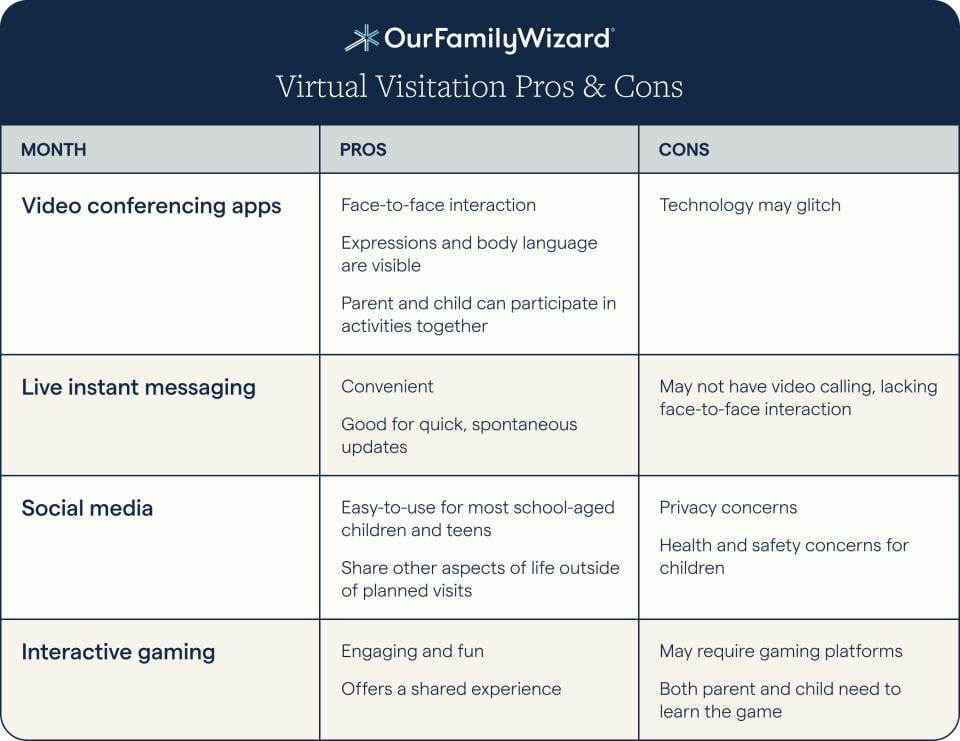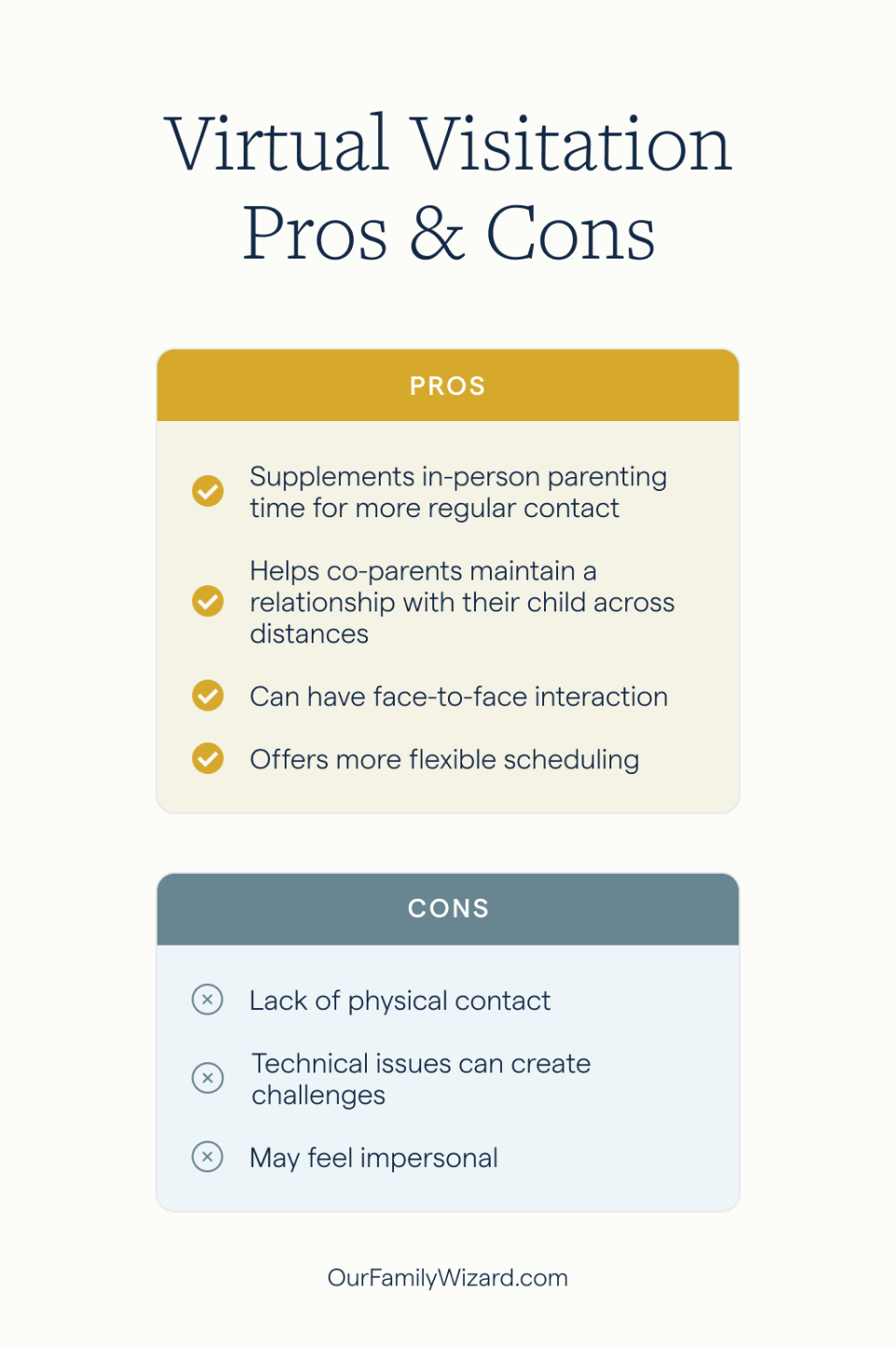Virtual Visitation for Co-Parents: Laws, Technology, and Ways to Connect
Time apart from your child is never easy. Learn how virtual visitation helps you spend more time together. Explore relevant laws, ways to connect, and creative online activities to stay connected. Plus, experts share tips on these topics.
What is virtual visitation?
Virtual visitation is when co-parents and children use technology to connect when they are not together in person. It complements in-person parenting time but does not replace it. It can be very useful when a co-parent lives far away or has a busy schedule.
The primary purpose of virtual visitation, also known as virtual parenting time, is to provide non-custodial parents with additional opportunities for long-distance parenting. In most cases, non-custodial parents who can't spend as much in-person time with their child ask for virtual visits. This is common for co-parents who live far away or have busy work schedules. It helps co-parents maintain a connection in between in-person visits, which can be infrequent because traveling with children can be difficult.
Liisa Speaker, a family law attorney who specializes in family law appeals and holds key positions within the State Bar of Michigan’s Family Law Section, American Academy of Matrimonial Lawyers, and the International Academy of Family Lawyers, describes the basics of virtual visitation:
positions within the State Bar of Michigan’s Family Law Section, American Academy of Matrimonial Lawyers, and the International Academy of Family Lawyers, describes the basics of virtual visitation:
“The basics of virtual visitation are straightforward,” says Speaker. “The bulk of a co-parent’s time happens in-person. But, depending on circumstances, like work, distance, and more, a co-parent might want to spend more time with their child. In today’s digital age, it’s more common to incorporate virtual visitation into parenting orders to help meet that need. In normal, non-supervised dynamics, it’s usually quite relaxed. For example, you might schedule a 15-minute chat before bed just to say goodnight.”
Shelley Kester, a Member of the Parenting Time Guidelines Advisory Committee, frequent ICLE presenter and President of Wilson Kester The Empowered Divorce Source, a state-wide family law practice, describes virtual visitation as a way to “maintain and foster the parent relationship.” Kester points out that virtual visitation has the added benefit of helping children maintain connections with other family members as well, which contributes to a child experiencing a unified family dynamic, even after a separation. “Children can visit with multiple relatives at the same time as they might have in the past, through virtual visitation. This can foster feelings of inclusion, togetherness, and create shared experiences for both sides of the family,” say Kester.
Bri an Garmo, family law attorney and partner at Garmo & Kiste, also says that the purpose of virtual visitation is to nurture a positive parent-child relationship. However, he emphasizes that virtual visitation should complement in-person parenting time, not replace it. "Physical time together is essential for forming strong bonds; there is no substitute for in-person connections,” says Garmo. “Virtual visits cannot replace that, but they do make bridging the gaps between visits easier and can strengthen the bond between a co-parent and their child.”
an Garmo, family law attorney and partner at Garmo & Kiste, also says that the purpose of virtual visitation is to nurture a positive parent-child relationship. However, he emphasizes that virtual visitation should complement in-person parenting time, not replace it. "Physical time together is essential for forming strong bonds; there is no substitute for in-person connections,” says Garmo. “Virtual visits cannot replace that, but they do make bridging the gaps between visits easier and can strengthen the bond between a co-parent and their child.”
In general, experts all agree that virtual visitation has the potential to improve the relationship between co-parents and their children, both in supervised and regular parenting schedules. It's a useful way to stay connected with your child using today's technology. However, like anything new, there are challenges to overcome along with the benefits. Fortunately, technology and legal guidelines are continually improving to address these issues.
Key takeaways:
- Virtual visitation allows co-parents and children to maintain and improve their relationships while they’re physically apart.
- Common activities include assisting with homework, sharing meals, and recreating other in-person experiences.
- Applying virtual visitation to supervised parenting holds potential, but experts are still developing guidelines.
- While most states lack specific virtual visitation laws, family courts generally grant judges the authority to order virtual visitation.
- The easiest way for a child and parent to connect online is through a co-parenting app with an integrated video-conferencing platform.
How does virtual visitation work?
Usually, the non-custodial parent asks to have virtual visits with the child. Occasionally, attorneys or mediators may suggest it, but court orders are still rare. Co-parents work together to establish guidelines for how the parent and child will connect online.
According to Garmo, co-parents typically discuss virtual visitation when one suggests it to enhance their connection with the child. Then, they might informally agree to virtual visits without including it in their parenting plan. However, the decision to integrate it into the parenting plan may depend on the stage of their divorce or separation when they discuss virtual visitation.
"In cases where couples are actively undergoing divorce proceedings and are working closely with their attorneys," Garmo explains, "it is more likely they will add provisions related to virtual visitation in their parenting plan—particularly if their legal counsel recommends it."
Garmo goes on to describe an alternative scenario: "Conversely, when a divorce has already been finalized, perhaps before virtual visitation was a common practice, co-parents might naturally decide to implement it without needing to revisit the matter in court. This is often the most typical scenario."
However, Garmo underscores that even after divorce, co-parents might seek legal intervention if they cannot mutually agree on virtual parenting time. He notes that while court-ordered virtual visitation is relatively rare, it can happen.
"Let’s consider a scenario in which the non-custodial co-parent consistently works 70-hour weeks and only has every other weekend with the child,” says Garmo. “If the co-parents have a difficult relationship and frequently argue over minor issues, the non-custodial co-parent might seek a court order to formalize their right to video calls.”
Once co-parents agree on virtual visitation, they typically work together to figure out the most suitable times for the child and parent to connect and decide on the duration of these calls.
The relationship between the co-parents affects how they organize virtual visits. Some co-parents might be content with relaxed and informal calls, while others may opt for a more structured approach, setting clear boundaries for these virtual visits. As with any parenting decisions, co-parents should consistently focus on identifying and prioritizing what's best for the child when crafting a virtual visitation plan or schedule.

Methods of virtual visitation for parents
Most co-parents use online video meeting platforms for virtual visits. You can also use live chat or instant messaging apps. Social media messaging or interactive game playing can also work. It depends on what the child and parent feel most comfortable with.
Virtual visitation once meant occasional phone calls and the rare email on a slow internet connection. Today, there are many more ways for co-parents to contact their children virtually. You can FaceTime, text, chat online, connect on social media, play online games, and much more.
The best method for your family depends on various factors including the child’s age and preferences, the co-parenting dynamics, and the relationship between the non-custodial parent and child. Regardless of the method, the primary goal is to maintain a positive child-parent relationship when in-person visits are not possible.
Here's a list of the common methods of virtual visitation and their pros and cons:
- Video conferring apps
Pros:
Face-to-face interaction: “The best parenting time is in-person,” notes Garmo. “But seeing someone’s face on camera and having an organic, real-time conversation is the next best thing. You can both see each other’s expressions, emotions, and more. It gives the children a sense of comfort that talking on the phone or sending an email does not provide.”
Video calls provide a sense of presence and connection, fostering a more intimate experience.
Most closely resembles an in-person interaction: “A video call lets you do a lot of activities that you would do in person,” says Speaker. “You can play games, help with homework, or share a meal together. It’s not the same as being physically together, but it’s the closest thing we have.”
Cons:
Dependence on technology: Technical issues, like a slow connection, can cause glitches, dropped calls, or frozen screens. These issues can disrupt the natural flow of the conversation and make the connection more stilted. - Live instant messaging (IM)
Pros:
Text-based: Instant messaging or chat platforms are well-suited for quick, text-based conversations that can happen spontaneously.
Convenient: This method can be less intrusive than video calls and accommodate busy schedules.
Cons
May not support video calls: While certain instant messaging apps support video chats, others are limited to text-only communication, which may make it more difficult to feel connected.
Potential for misinterpretation: Texting can sometimes lead to misunderstandings. - Social media
Pros:
Familiarity: Many people, especially young people, use social media apps regularly. Therefore, connecting with a parent over these channels may be second nature and reduce awkwardness.
Varied communication: You can connect with one another on social media via public posts or use the messaging app to directly message (DM) each other.
Share aspects of life outside of planned visits: Many people use social media to update their friends and family about their lives. This means that the child or their parent can use social media to send updates outside of their live, planned virtual visits.
Cons:
Privacy concerns: Co-parents may have reservations about privacy on public social media platforms.
Concerns for child health: Social media can have harmful effects on young people’s self-esteem and screen time. Using it for virtual visitation might encourage a child to use the apps more than their parents may be comfortable with.
Doesn’t allow live video calls: While not the case for all social media apps, many don’t support live video chats.
Distractions: Children may become distracted by other content on social media while they’re trying to engage in a virtual visit. - Interactive gaming (for example, online multiplayer games)
Pros:
Engaging and fun: Playing games together can be an enjoyable way to connect and bond.
Active participation: Interactive gaming encourages direct involvement and collaboration.
Shared experiences: Parents and children can create shared memories through gaming.
Cons:
Technical requirements: Both parties need compatible gaming platforms and a strong internet connection.
Age-appropriate content: Parents should ensure the games are suitable for the child's age.
Potential for disputes: Competitive games may lead to conflicts related to gameplay.
Types of virtual parenting activities
Some common virtual parenting activities recreate in-person activities. For example, you can play online games, help with homework, tell stories, or share a meal. You can also go on virtual outings or field trips and explore together.
Some co-parents may use virtual visitation as a chance to simply reconnect and chat about life. However, if you plan to have frequent virtual visits, you might consider incorporating more structured activities to make the most of your time together and create some shared experiences.
"When planning activities," advises Kester, "it's crucial to tailor expectations and the conversation to those that are age and developmentally appropriate, engaging and fun for your children. For young children, that might be talking about games they played, reading a book together or talking about favorite animals. For school age children it might be asking about what they learned at school, engaging in conversations about hobbies or sports that interest them or talking about their friendships and social interactions they have had. It can also be used as an opportunity to encourage them to talk about current challenges that they are facing and helping to support them to find solutions. By doing so, you can engage in activities that are most suitable for their age group and their interests."
Kester continues with broader recommendations: "Regardless of age, it's important to avoid interrogating the child about their time with the other parent. Instead, transform the visit into an opportunity to strengthen your bond and enjoy quality activities that enhance your relationship."
Here's a list of other virtual parenting activities you can try:
- Online games: Try playing multiplayer video games or virtual board games and puzzles.
- Homework help: Help with school assignments via virtual study sessions.
- Storytelling: Share or create stories through video calls.
- Virtual meals: Enjoy a meal together over a video call.
- Virtual field trips: Many museums, zoos, historical sites, and more offer “virtual field trips” where you can take a virtual tour of the location.
- Arts and crafts: Try collaborating on creative projects or sharing each other’s latest creations.
- Virtual movie night: Watch movies or TV shows together while discussing them in real-time through video streaming
- Virtual reality: Dive into online virtual reality games to explore immersive worlds together.
- Interactive learning: If you have a shared interest, you can engage in educational activities, like language lessons, together.
Virtual visitation laws and legislation
Virtual visitation laws vary by jurisdiction. Some states have laws that allow judges to order virtual visitation. Even in states that don’t have specific virtual visitation laws, a family court judge can order virtual visitation.
What states have virtual visitation laws?
As of 2023, several states have virtual visitation laws including Utah, Wisconsin, Florida, Texas, North Carolina, Illinois, and Missouri. Other states are considering adding virtual visitation laws to their state code. In states without specific laws, family courts can still order virtual visitation.
What does it mean if a state doesn’t have virtual visitation laws?
If a state doesn’t have virtual visitation laws, it means that there are no legal provisions that regulate virtual visits in that state. That doesn’t mean that you cannot use virtual visitation. Instead, it gives family courts more discretion in handling virtual visitation.
Why is virtual visitation more common?
Virtual visitation became more common during the COVID-19 pandemic because it allowed non-custodial parents to be safely apart from their children and still maintain a relationship. Also, video conferencing apps have improved, making virtual visits easier.
According to Kester, the COVID-19 pandemic accelerated the adoption of virtual visitation. For example, the pandemic normalized remote interactions and drove the development of user-friendly video apps. Kester adds, "In a world where digital experiences are now the standard, it's no surprise that co-parents are readily embracing the opportunities that come through virtual interaction to enhance their parenting time."
When is virtual visitation an option?
Virtual visitation becomes an option when it's in the child's best interest. Usually, co-parents who live far away, have busy work schedules, or must exercise supervised parenting time use virtual visitation. Co-parents don’t need a court order if they agree to use virtual visitation.
When will judges allow virtual visitation?
Judges make the decision to allow virtual visitation based on several factors. The primary consideration is the best interest of the child. The judge also considers geographic distance, health or safety concerns, parent-child bonds, and the co-parenting dynamic.
What guidelines are set for virtual visitation?
Co-parents establish guidelines for virtual visitation to ensure that the visits support the relationship between the child and their parent. These guidelines often include rules for the call frequency, scheduling, and platform. Some may need to define privacy boundaries and address any supervision issues.
"Usually, there are no defined legal standards governing virtual visitation," states Garmo. "Unless a court mandates virtual visitation in states with established laws, co-parents often establish informal guidelines. These may be crafted independently or with the assistance of their legal counsel or mediator. These guidelines typically include scheduling and selecting a platform. Of course, you will want to get the child’s input on everything, assuming they are old enough.”
"The need for establishing guidelines varies depending on the co-parent-child and co-parent-co-parent dynamics," says Speaker. "In high-conflict situations, it's best to outline specific rules regarding the timing and duration of virtual visits to prevent future conflicts. Conversely, amicable co-parents may opt for a more flexible approach.”
Kester advises that co-parents establish a mutual code of conduct to guide virtual parenting time, saying, “Co-parents should collaboratively decide on effective yet unintrusive methods to observe their young child for safety while respecting the other parent’s virtual presence. At times, one parent may perceive that the other is overstepping by either watching too closely or unduly influencing the child during these sessions. On the other hand, a parent may worry that supervision is necessary for the safety of the active child. Clear, respectful communication about guidelines and reasonable duration of virtual parenting time, with consideration of the child’s limited attention span and need for suitable supervision, is essential. Recognizing and integrating both parents’ viewpoints is the mark of successful co-parenting and becomes particularly pertinent for virtual interactions.”
Here's a list of guidelines to consider when establishing mutual expectations for virtual visitations:
- Platform: Specify how the parent and child will connect online (for example, video calls, phone calls, messaging apps) and ensure that they both understand how to log in and use the platform.
- Scheduling: Establish a regular schedule for virtual visits, including the day of the week and time of day.
- Duration and frequency: Determine how many times a week the virtual visit will occur. Also, establish how long each session will last.
- Technical issues: Develop guidelines for handling technical issues or interruptions during virtual visits. For example, will the child need assistance from the custodial parent, or can they handle it on their own?
- Privacy and supervision: Maintain the child's safety during virtual visits while also respecting the parent's privacy needs. Younger children may need more supervision compared to older children.
Supervised virtual visitation
In supervised virtual visitation, a court mandates that a third party oversees virtual visits. Courts order supervised visitation when there are concerns about the child’s safety and well-being or the parents’ conduct. It allows the non-custodial parent to maintain contact while addressing any risks.
A robust body of research endorses supervised visitation as an effective approach to repairing the parent-child relationship. Judges may order supervised visitation when there’s a history of serious issues like domestic abuse, child abuse, or substance abuse. The goal is to help the child and parent maintain a connection with the aim of re-establishing a normal, in-person relationship. Recently, virtual visitation has emerged as a practical means to facilitate some supervised visits. In these visits, a third-party professional logs on to the online call with the child and parent to facilitate their interactions.
"Supervised virtual visitation has become more popular to help co-parents maintain their relationships with their children while addressing genuine safety concerns," Speaker explains. "During the early days of the COVID-19 pandemic, supervised parenting facilities shut down, causing immense hardship as many parents and children were unable to meet due to the need for third-party supervision. Virtual visitation emerged as a lifeline during those challenging times."
Speaker further emphasizes that supervised virtual visitation becomes essential in specific scenarios where it might be the only way for a parent and child to connect. "Consider a situation involving a history of domestic violence between the parents or abuse of the child by the non-custodial parent,” says Speaker. “When the situation warrants it, there's often a restraining order to limit contact with the child or parent. However, the parenting plan likely still gives the perpetrator the right to communicate with their child. Yet, in cases where the child is the victim, in-person visits will compromise the child’s safety and violate the restraining order. Supervised virtual visitation, especially when integrated with features like geolocation tracking and recorded calls, can be the solution. Virtual visits provide judges and the other parent with peace of mind while allowing the offending parent to maintain a connection with their child and uphold their parenting rights outlined in their parenting plan."
How supervised virtual visitation works
In supervised virtual visitation, a third-party supervisor joins the online platform with the parent and child. The supervisor's role is to oversee the interaction and ensure safety. They typically have the authority to end the virtual visit if necessary.
"Virtual visitation has a lot of potential to help facilitate and enhance supervised parenting time," emphasizes Speaker. "For instance, it can be the initial reconnection tool following a period of separation, helping the parent and child gradually re-establish their relationship. However, as with any supervised visitation, it's crucial to maintain stringent guidelines and ensure a supervisor is present during these interactions to guarantee safety and compliance with court orders."
The COVID-19 pandemic did provide an interesting, forced testing ground for supervised virtual visitation. In the 2021 paper “Online Virtual Supervised Visitation During the COVID-19 Pandemic: One State’s Experience” in the Family Court Review family law journal, the authors highlighted the opportunities and challenges of virtual visitation. These include making sure that the parents can wait in a virtual waiting room, that the supervisor can mute the participants, and that the supervisor can record and end a visit if necessary.
Here’s a summary of some of the key guidelines that the authors suggest implementing for effective supervised virtual visitation:
- Virtual waiting room: Implement a virtual waiting room for parents to wait before joining to ensure readiness and safety.
- Mute capability: Provide the supervisor with the ability to mute participants if necessary to prevent harassment, threats, or legal case discussions.
- Emergency termination: Include the option to end visits for all participants, considering potential platform issues.
- Privacy features: Allow for virtual backgrounds or photos to protect the homes from view if desired.
- Cost-effective access: Offer free access to the electronic platform, considering budget constraints of supervised visitation programs.
- Room scanning: Outline a procedure for parents to scan the room to ensure compliance with visitation terms and attendance restrictions.
- Media restrictions: Prohibit parents from taking photos or videos during virtual visits unless explicitly allowed by the court.
- Supervisor control: Define the supervisor's authority to mute or remove a parent and use a virtual waiting room to manage the visit effectively.
Additionally, it's essential to ensure that the chosen virtual visitation platform is secure and compliant with all necessary legal requirements, including the protection of sensitive information. Regular training for staff on virtual visitation procedures and technology usage is also important to ensure smooth, effective supervision.
Benefits of supervised virtual visitation
The main benefit of supervised virtual visitation is that no one must travel to attend the visits. Also, families can usually schedule more frequent visits. It also helps parents and children under graduated parenting time schedules ease back into their relationship.
- More flexibility in scheduling: More time slots are available for virtual visitation because the parties don’t need to find a time that they can both travel to the supervising office. For example, a working parent could schedule a call on a work break, if that’s easiest for everyone involved.
- Convenience: The convenience of virtual visitations made it easier for co-parents to stick to their appointments. This can lead to fewer last-minute cancellations, according to the 2021 paper Online Virtual Supervised Visitation During the COVID‐19 Pandemic: One State’s Experience.
- Improved accessibility: Parents with physical limitations or health issues will find virtual visits easier to attend. It’s also helpful for co-parents who live far away from supervision centers.
- Opportunity for more frequent meetings: Without travel time, parents can visit with their children more frequently. Also, families can opt for multiple shorter visits per week if they prefer.
- Opportunity to interact with the child in their natural setting: When safe, parents can see their children in their natural home environment rather than in an office setting.
- Less obtrusive supervision: “You can really feel the presence of the supervisor during in-person visits,” describes Garmo. “They are always seated nearby since they need to be able to hear the conversation and watch for any inappropriate behavior. In virtual visits, their presence feels more subtle, which can foster more organic conversations between the parent and the child. Of course, the supervisor still retains all their ability to hear the conversation and intervene if necessary.”
- Very helpful to fulfill graduated parenting time schedules: Virtual visits can be a stepping-stone toward re-establishing a normal parent-child relationship. It offers a safe transition to in-person visits.
Benefits of virtual visitation
The main benefit of virtual visitation is that it offers co-parents and children a way to stay connected even when they’re far apart. It’s also usually more flexible to schedule virtual than in-person visits. Also, many online platforms have video capabilities that enable you to interact face-to-face.
Here's a list of the main benefits of virtual visitation:
- Maintain a relationship across distances: “The best thing about virtual visits is that they’re perfect for supplementing your in-person time, particularly if you live far away or have a busy schedule” says Speaker.
Virtual visitation keeps you in touch when seeing each other in person requires either the child or co-parent to travel. These in-person visits can happen infrequently, especially if they involve out-of-state trips that can be difficult and costly to arrange. Virtual visitation helps bridge the gap between these trips. - Can provide regular and consistent interaction: Besides distance, other factors can interrupt a parent’s ability to interact with their child, like work and school. Virtual communication helps bridge this gap and keeps co-parents updated on their child’s day-to-day lives.
- Flexible scheduling: Virtual visitation offers greater flexibility in scheduling, which helps to accommodate diverse daily routines.
- Face-to-face interaction: “The extent of virtual visits used to be a telephone call,” says Garmo. “Today, it is very easy to pick an app and immediately be able to see your child. You can do so much that you could also do in person, like helping with homework or reading a story. These face-to-face interactions are second only to in-person meetings.”
- Flexibility to virtually attend important events: Co-parents who live far away can virtually attend some important events that they would otherwise not be able to see.
Challenges of virtual visitation
The major challenge of virtual visitation is the same as its defining feature: it does not allow for in-person interactions. Technical difficulties can also interrupt virtual visits. Privacy and security concerns can also be challenging to address.
Here's a list of the main challenges of virtual visitation:
- Lack of physical contact: The biggest disadvantage of virtual visits is the lack of physical visits. “Despite all of the advantages of virtual visits, they will never replace the experiences you have together in person,” says Garmo.
“All relationships need some in-person, physical contact—particularly those between a parent and young child,” says Speaker. “Virtual visitation simply cannot meet this need.” - Technical issues: Poor internet connection, software glitches, or hardware problems can disrupt virtual visitation sessions, making it difficult for parents and children to communicate effectively.
- Age-appropriate limitations: “Younger children may struggle to understand or adapt to virtual visitation, and it can be challenging to hold their attention during video calls,” says Speaker.
- May feel impersonal: Virtual visitation can sometimes feel less personal, making it difficult for parents and children to connect on an emotional level.
- Balancing screen time: Striking a balance between virtual visitation and other activities in a child's life, such as schoolwork, extracurricular activities, and playtime, can be challenging.
- Ambiguous guidelines: The legal system may not always provide clear guidelines for virtual visitation, which can lead to disputes and uncertainty.

Expert tips for using virtual visitation in your parenting plan
Experts recommend setting clear expectations about when and how a parent and child will communicate. Also, keep a consistent schedule for virtual visits and consider the child’s age when selecting a platform.
“It’s critical that both co-parents understand what the virtual visits will look like,” says Speaker.
Here are some tips from family law experts on how to incorporate virtual visitation into your parenting plan. Please note that these guidelines refer to general, unsupervised virtual visitation. If you’re using supervised virtual visitation, be sure to include the guidelines we provide in the section on supervised visitation.
- Be specific and consistent: Clearly define when virtual visitation will occur, specify the day or day of the week, and try to maintain a consistent schedule. Determine whether visual contact (video calls) will be a part of the virtual visits.
- Identify the technology: “Pick the technology you will use and try a test run before involving the child,” says Garmo. “This will help avoid any technical issues during the visit and get you off to a great start.”
- Have age-appropriate visits: Adjust the length and frequency of virtual visits to match the child's age and developmental stage. Younger children may need shorter, more frequent visits, while older children may be comfortable with longer sessions.
- Coordinate with in-person visits: Whenever possible, schedule virtual parenting time to align with your regular in-person interactions with the child. This helps maintain a sense of consistency in the child's life.
- Ensure that the level of privacy is right: If the virtual visitation is unsupervised, make sure that the environment of the call is secure and private to ensure comfort for everyone on the call.
- Plan for potential issues: “What will you do if the video freezes, or the child doesn’t want to participate?” asks Speaker. “Also, what happens if the child has an outburst or behaves inappropriately tomorrow?” Make sure you have plans for how you will react to these scenarios.
- Recognize that it might be difficult for the child to stay engaged: Understand that it may be difficult for the child to stay engaged during virtual visits, especially for extended periods. Be patient and flexible.
- Consider separate virtual visits for multiple children: If you have multiple children with a significant age difference, consider arranging separate virtual visits tailored to each child's needs. Younger and older children may have different preferences and needs during these sessions.
The future of virtual visitation for co-parents
The future of virtual visitation will be shaped by technology that will make virtual visits easier. Innovations like virtual reality may provide more immersive experiences. Also, more states will adopt legal frameworks that establish clear guidelines.
“Virtual visitation is here to stay,” asserts Kester. “It is now a permanent aspect of most parenting time agreements. We can expect technological advances to continually enhance the quality of virtual interactions, making them increasingly immersive and lifelike. As improvements in technology make these experiences even more rewarding, families are likely to continue to recognize that virtual parenting time is a significant adjunct to traditional face-to-face parenting time.”
OurFamilyWizard CEO Nick VanWagner predicts that virtual visitation will become a fundamental part of many co-parents' lives. “Our app’s video calling platform is designed specifically for co-parenting. It carefully documents every video and audio call between parents and their children in the same central spot where other co-parenting tasks are managed. This is extremely helpful for creating transparency between co-parents and their family law professionals about virtual parenting time. As more families continue to embrace this technology, we’ll continue improving the virtual visitation experience to help co-parents and their children maintain strong relationships, even at a distance.”
Here are some trends that give us a glimpse into the future of virtual visitation:
- Virtual visitation will become more common: Experts agree that as technology improves, the digitization of our daily lives, including co-parenting, will continue to increase.
“I see virtual visitation more and more in parenting plans,” adds Garmo. “I do not expect this trend to slow down, in fact, I bet it will only speed up as new apps develop and we are able to close the gap even more to provide the best possible experience online.” - Advancing technology may make virtual visits more engaging: New technologies like augmented and virtual reality offer exciting possibilities to make virtual visits feel more immersive and life-like. However, some experts worry that too much online time could reduce the desire for in-person interactions.
- Enhanced privacy and security measures for supervised virtual visitation: “We can still improve how we apply virtual visitation to supervised visits,” says Speaker. “For example, we can develop specialized apps designed explicitly for supervised virtual visitation. This way, someone can make a call without a cell phone number, which provides a high level of security and privacy. Additionally, we can integrate tone readers into the app's recording platform to assist co-parents in maintaining focus or to alert the supervisor to potential issues on the horizon."
- Legal framework will continue to develop: The legal landscape surrounding virtual visitation may continue to evolve. More states will formally address virtual visitation in their code and may adopt formal guidelines and regulations to address the use of virtual visitation in parenting plans.
Easiest virtual visitation solutions for co-parents
Calls on OurFamilyWizard is a fantastic solution for parents and children to connect online. With features that support virtual visitation, calls made through the app help make physical time apart feel more manageable.
Whether you need to schedule visits, share information, or coordinate with your co-parent, OurFamilyWizard provides the tools you need to communicate, stay on the same page, and make sure both co-parents have frequent, meaningful contact with the children.
All calls made through the app are thoroughly documented, from the moment a call is place to when it is ended. Plus, the app will document in-call activity like if someone mutes their audio or turns off their camera during a video call, helping you capture a record of what occurred during each call.
Using Calls, co-parents do not need to exchange phone numbers. Audio and video calls are placed straight through the app, which helps keep each parent’s personal information secure and private.
Virtual Visitation FAQs
Explore frequently asked questions about virtual visitation. Learn if you need a lawyer to obtain virtual visitation and whether it impacts child support calculations. Explore how to take your child’s age into account when developing a virtual visitation plan.
Is it necessary to consult a lawyer to obtain virtual visitation?
In most cases, you don’t need to consult a lawyer to obtain virtual visitation. Co-parents can often work out virtual visitation arrangements themselves or with the assistance of family mediators. However, legal advice may be necessary in complex situations or when disputes arise.
Which co-parent sets up virtual visitation?
Both parents share this responsibility. Normally, the parent who doesn't have primary custody requests virtual visits. But it's vital for both to cooperate and agree on how these visits will work.
Can a judge order virtual visitation?
Yes, it's possible for virtual visitation to be included in a judicial decree. Courts recognize the importance of virtual visitation, and judges can legally mandate these visits as part of a parenting plan.
Which types of co-parents use virtual visitation in custody agreements?
Co-parents who want to supplement their in-person parenting time use virtual visitation. Usually, these parents live far from their children or have busy work schedules. Some parents with supervised visits also use it in their custody agreements.
How does virtual visitation strengthen the child-parent bond?
Virtual visitation strengthens the child-parent bond by helping them connect regularly, even when they can’t be together in person. It helps them see one another and maintain their relationship.
Which adverse impacts of divorce can be mitigated through virtual visitation?
Virtual visitation can help ease the challenges of divorce by allowing parents and children to stay connected even when they can't be together. This can reduce feelings of separation. It can also help ease conflict between parents by reducing the time that they have to see each other in person.
Do virtual visits count towards child support?
Virtual visits do not count towards child support payments. Family lawyers and judges determine child support based on the in-person parenting schedule and the financial situation of each parent.
How does the child’s age affect virtual visitation?
The age of the child can influence virtual visitation needs. Younger children may benefit from shorter, more frequent visits and might need help using technology. In contrast, older children can handle longer talks and may need less help with technology.
A Note on Terminology
In general, the term “physical custody” refers to which parent a child lives with. Today, many experts use other terms to describe this arrangement, like “parenting schedule” or “parenting time arrangement.” These new terms better represent a relationship and the parent’s responsibilities for their children. But just a heads up: this article uses these older and newer terms interchangeably.




